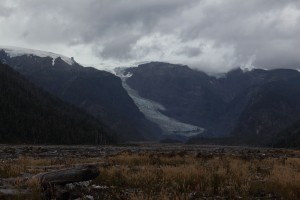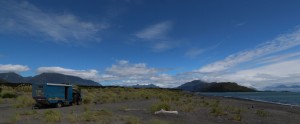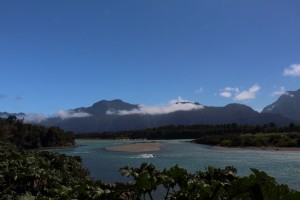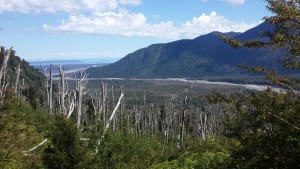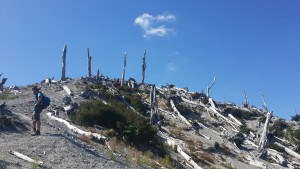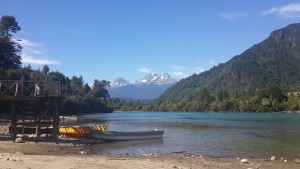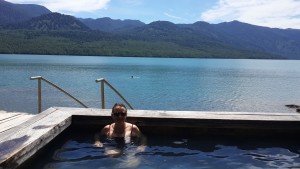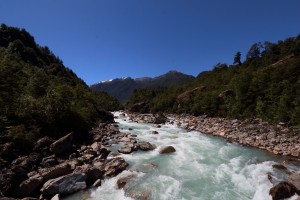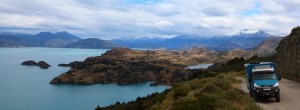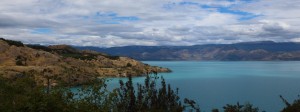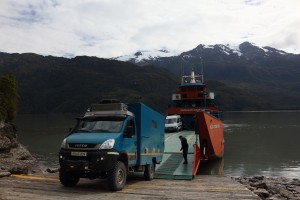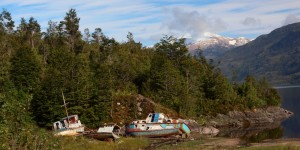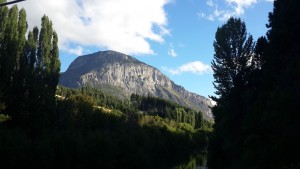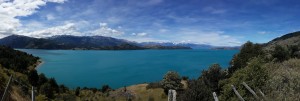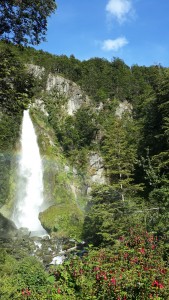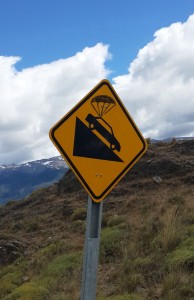High on the list of ‘World’s Most Iconic Road Trips’, Chile’s Carretera Austral is a long, scenic drive down the western side of the southern Andes. It runs some 1,200 km south from its start in the city of Puerto Montt. As with Ruta 40 in Argentina, you can’t really say that you’ve ‘driven Chile’ unless you’ve done ‘The Carretera’. So here we go… starting our Carretera Austral Blog, where else, but at the end.
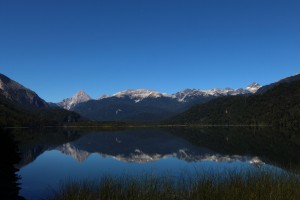
Stunning views along The Carretera
Heading to start at The End
Construction of the Carretera was General Pinochet’s attempt in the ‘80s to unite the southerly remote sections of Chile which were inaccessible by road. However, the builders were defeated by the impenetrable mountains and never quite made it through to the very far south. The Carretera Austral therefore ends rather abruptly at a latitude of around 48.5° South in a (literally) dead-end village with the not-so-very latino name of Villa O’Higgins.
After crossing into Chile from Argentina, we planned to join the Carretera Austral at the most southerly point possible, near the town of Cochrane. This is towards the southern end of the Carretera, but we will need to head south for the last 200km to the end at Villa O’Higgins. “Err… you just say it dead-end. Whyfor you go dead-end?”. Well… probably just because it’s there, and because we can. It’s reportedly a scenic drive. And because it’s good to start at the end 🙂
But first we need to get to the end so that we can start there! At the Paso Roballos border crossing we were of course anticipating the ‘normal’ food palaver for the Chile arrival (we’ve done it enough times now to know the protocol). However, we weren’t prepared for the process of leaving Argentina. It was the first time that we can recall in all our travels that we have been searched and subjected to fairly rigorous questioning when departing a country. The officer searched all our cupboards, confiscated and destroyed some of our food, quizzed us on what we were doing, what we had bought in Argentina. Either we look like some dodgey traffikers of lethal cream-cheese, or he was very, very bored.
Cochrane ‘Wonder-store’
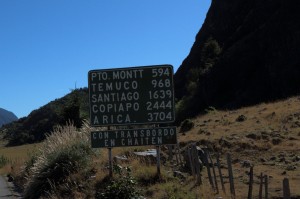 Anyway, we’re into Chile again now, joining the Carretera Austral and our first stop is the one-horse-town of Cochrane. We haven’t been near a village of any size for around 10 days, so some fuel, some supplies and (hopefully) a phone signal with data/internet will be a treat. Cochrane is a small outback centre to which farmers and gauchos from the region’s estancias make a monthly pilgrimage – meeting-up and buying supplies.
Anyway, we’re into Chile again now, joining the Carretera Austral and our first stop is the one-horse-town of Cochrane. We haven’t been near a village of any size for around 10 days, so some fuel, some supplies and (hopefully) a phone signal with data/internet will be a treat. Cochrane is a small outback centre to which farmers and gauchos from the region’s estancias make a monthly pilgrimage – meeting-up and buying supplies.
In the central square is the town’s shop, the Melero Store. In around 150–200 sqm of floor space, it stocks one of almost every item under the sun. It has food, furniture, plumbing and heating equipment, musical instruments (including violins and not one, but a selection of accordions), all types of clothing and shoes for adults and children, cattle whips and yokes, washing machines and small electrical equipment, power generators, various types of firearms (and for that added element of security, the appropriate ammunition kept in the same display cabinet as the weapons!), toys, books, crockery and cookware, babycare, hardware and DIY tools, bathroom and kitchen fittings, a wide selection of alcohol, fabrics and haberdashery, gardening items, car parts/oils and motoring accessories… we could go on and on! It was like taking a step back in time, as much of the stock had a distinct 1970s feel to it.
What the store lacked was (understandably given its remote location and how little horticulture there is out here) any fresh food – no fruit, veg, meat or fish. All the food items were of the long-life variety: packet or tinned. So far on this trip in South America we have been spoiled with fairly wide availability of good fresh produce; now it’s almost like being back in rural Africa (well it’s not quite that bad, at least here there is reliable electricity for some refrigeration here, even if there are few items needing it).
We buy what food items we can, but end up with a somewhat random selection of tins and packets from which some rather bizarre meals will have to be concocted. UK peeps may be familiar with the daytime TV programme ‘Ready, Steady, Cook’, where contestants bring a random selection of food items and professional chefs have 30 minutes to turn the ingredients into a gourmet meal. Well Cuthbert’s food-store at the moment is a bit like that show, with ingredients such as: pasta, dried lentils, tinned tuna, porridge oats, chocolate biscuits, pistachios and long-life milk. It won’t be gourmet, but we won’t starve 🙂 .
The End, in the rain
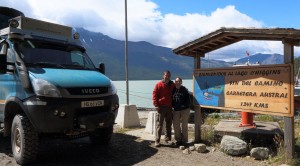
Fin del Camino – and a gap in the rain.
Leaving Cochrane we take the Carretera on our de-tour south to Villa O’Higgins so that we can start at the end. Over the last few weeks we have been blessed with spectacularly good weather; now we have low clouds and rain. If there is any beauty in the drive to Villa O’Higgins, it escapes our attention. People have told us that this western side of the Andes receives much more precipitation than the drier east side; and they weren’t wrong 🙁 .
Anyway… notwithstanding the poor weather, we pressed on. About half way to Villa O’Higgins the route is interrupted at Puerto Yungay by a short ferry then the Carretera continues for another 100km to the end. It is as Lennon and McCartney once said, a ‘long and winding road’ which leads not to your door but more predictably, to a ‘Fin del Camino’ (End of the Road) sign. That’s it. We’re there. We can now start the Carretera Austral at the end.
We had thought it might be nice to stop in Villa O’Higgins (about which incidentally, there is very little to say) for a couple of nights to enjoy the area, but the aforementioned bad weather continues, so there is little point. The next day we head back north, slightly disheartened by the poor weather, but almost certainly nowhere near as disheartened as the many crazy long-distance cyclists that we pass on the Carretera (particularly those sat in the verge, getting very wet, with an upside down bike, changing a tyre). We really can’t see the attraction of tackling such long routes on a bicycle, but the Carretera seems very popular amongst the long-haul cycling community – we can only conclude that if they had worked a bit harder at school, they might have been able to afford an engine for it 😉
Back to Northerly
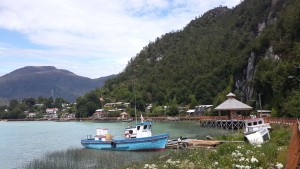
Caleta Tortal
So after our little detour to the south, we are back pointing north. We retrace for 200km our steps back as far as Cochrane (cue another visit to the Melero wonder-store) and on the way we drop in to the fishing village of Caleta Tortel. Perched on the hillside overlooking the ocean in-let, the village has no roads or tracks at all. Vehicles must park at the end of the road and pedestrians take to a net-work of stilted boardwalks to reach the stilted buildings. The several miles of wooden walk-ways require a significant amount of maintenance and apparently UK’s very own Prince William spent some time here as a volunteer during his gap-year. We’re sure the skills he learned here will suit him well for his long-term career aspirations 🙂
The weather is now improving again and the Carretera Austral continues ever northwards through some spectacular scenery. Along the eye-piercingly blue Río Baker and we find some great spots to park-up overnight. The valley is a top destination for high-end ‘trout-tourism’. Hopefully the international jet-setting fishermen who pop down here to relax (and no doubt, to get away from Blackberry contact with their stock-brokers) will nab a trout somewhat larger than the one we managed back in Lago Posada a couple of weeks ago 🙂
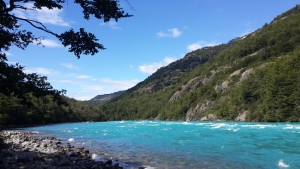
View from camp on the (doomed?) Rio Baker
Controversially, the stunning Río Baker area is planned for damming and construction of a hydro-electric power station. The proposed construction of the dam and power-station is a highly contentious subject in its own right, but there is an additional controversy in that they are proposed to supply power not to the local area, but to the industry of northern Chile over 1,500 km away. This would, if it goes ahead, require the construction of the world’s longest power-grid lines, setting a network of huge pylons and cables through the middle of Chile’s most coveted and spectacular landscapes. Hmmm… what price progress???
Anyway… for now at least, the picturesque scenery remains untouched by such development and we continue: over rivers, between mountains, past glaciers and around lakes to the village of Villa Cerro Castillo. Here we visit an interesting small museum telling of how communities survived and how children were educated before the area was introduced to the 20th Century by the first road in the 1980s. The stories on the displays read like accounts from European children of the 1920s and ‘30s, but these were tales from children of our own generation at school in the early 1970s. Historical museums used to be about ancient civilisations, or maybe some old guys in wigs! Now we find a museum of historical interest depicting an era of our own lifetime. Oh, we feel old!
Quiet Night in Coyhaique
Wandering up the Carretera again, more amazing scenery and we reach the civilization of Coyhaique, a ‘proper’ town with a large modern super-store! Plenty of fresh produce and even some international brands on the shelves: scrumptious chocolate biscuits all the way from our favourite store in UK, Waitrose!!
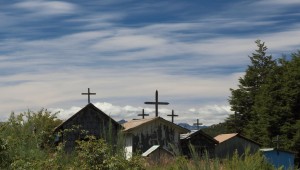
Looks like a few didn’t make it down the whole Carretera!
After some retail therapy we moved out of town to a nice spot by a small river to park for the night. All was very peaceful as we sipped a glass of marlbec, munched our Waitrose choccie biccies and watched the sun go down. But in the early hours of the morning, a car turned up with a couple of young men who were enjoying a drink or three. And what else does one need for a little party by the river, but music and entertainment.
The car stereo came on (loud, of course) and the entertainment consisted of them trying to drive the car through the river. Fortunately for them the river wasn’t very deep, but less fortunately for them, the car got stuck in the river-bed. Another car turned-up (let’s call this ‘Car B’) with a plan to tow ‘Car A’ out of the river. However, driver of Car B was in a similar state of inebriation as driver of Car A and the plan didn’t quite come off. They spotted a German campervan parked a little way down the bank and decided to seek their assistance which was, understandably, gruffly rebuffed.
At this point they spotted Cuthbert parked off to one side in the darkness, but unfortunately they were operating under the fundamental misconception that we might care more than the Germans did. One of them knocked on our door and whined for help to tow his car. Call us miserable old spoil-sports if you like, but we were certainly not intending to get out of bed in the middle of the night to tow his car out of the river so that he could continue a drunken joy-ride.
It was a little unnerving trying to sleep through this, but eventually they seemed to get bored and fall asleep, that is until dawn when they decided to re-start the party and re-attempt the rescue mission which this time was a success. By the time we had got-up to leave, they were standing around their cars chatting and gave us a smile with a polite wave as we drove away. Bizzarre!
In addition to shopping for yummy choccie biccies in Coyhaique, we also had to book our ferry for the northerly section of the Carretera Austral. There is a long section of the Chilean coast some 300km north of where we are now, through which the road-builders couldn’t pass and which has to be circumvented with a 5 hour car ferry. In this peak summer season the ferry gets booked up in advance and to make a reservation we need to decide how long it is going to take us to get to the port of Caleta Gonzalo. Hmmm… this is a tough one. We don’t do planning ahead, and we hate creating deadlines for ourselves. What if we like the next place we come to and want to stay a few days? Well we’ll just have to ‘suck it up’ as they say… the alternative is to get to the port and then wait some days for a place on a ferry. So now we have a deadline of seven days to get to the ferry port at Caleta Gonzalo.
Glacier, just ‘hanging’
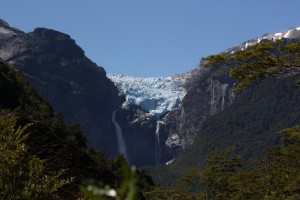
Glacier… hanging in there
So far on our way through ‘glacier-land’ we’ve done a marvellous whiskey-ice-hike on the Perito Moreno and seen other smaller ones on our way up the Carretera Austral. Now we’ve reached the Ventisquero Colgante (Hanging Glacier) of Parque Queulat. The hanging glacier sits in a deep saddle-valley perching high between two mountains. The glacier valley ends abruptly in a sudden drop of hundreds of feet, down a sheer cliff-face into a clear blue lake below. As the glacier melts and slides down the suspended valley, it forms water-falls and causes cascades of ice to fall down into the lake. We hiked to a viewpoint across the valley in front of the glacier. The visual spectacle is impressive but even more astonishing is the noise. Much louder than the normal gushing sound of a large waterfall, is the deep rumble and cracking of the ice chunks breaking off the end of the glacier and smashing down the precipice below. All a bit spectacular.
Back to Cuthbert and a few kilometres up the road are some thermal spring spa-baths. Lovely hot-pools set on the lakeside with great views to boot! Just the trick to sooth the aching limbs after the morning’s hike… And relax! 🙂
Can’t stop… got a boat to catch!

Another tough camp-spot!
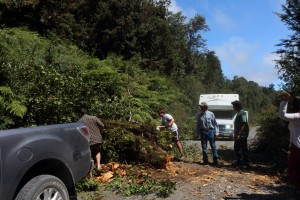
Helping the locals
Late afternoon we found one of the most beautiful camp-spots ever. Just a few kilometers off the Carretera Austral we found the wide, flat, grassy shore of the clear blue Lake Rosselot. All very picture-postcard stuff. The following night we found another marvellous spot, this time on a beach near the snappily named village of ‘Puerto Raul Marin Balmaceda’ (try saying that quickly after a couple of beers!). A tree had fallen across the road to get there, so there was a short delay to our arrival whilst we stopped to help the locals hack it away. We don’t find wild-camp spots of this calibre every day and it’s soooo frustrating to find them right now. These are exactly the kind of places we feared when the ferry booking set a deadline! Had we not been in the straight-jacket of a ferry booking, we would have stayed at least a couple of nights at each of these great spots. But we need to keep moving on to comply with the dratted timetable… Grrrrh!
Parque Pumalin
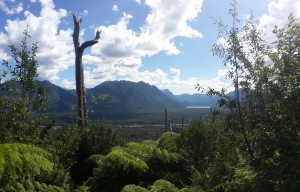
Parque Pumalin
One of the things that we left time to see on our way to the ferry port was Pumalin Park, reputedly a very worthwhile stop-off along the Carretera Austral. On our way there we passed yet more great scenery and glaciers (including another hanging glacier at Ventisquero Yelcho) and when we get to Pumalin Park, what we do? Yes… another hike to see another glacier. We’ve seen sooo many of these now (yawn! 🙂 ) but actually they are each rather different and interesting in their own way. We don’t tire of the them, at least not yet.
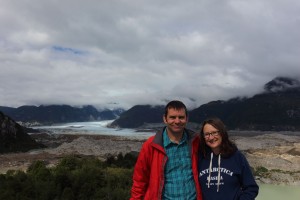
More glaciers!
Pumalin Park was, incidentally, established by Doug Tompkins the co-founder of North Face who died tragically in a kayaking accident just a few weeks ago. He apparently bought-up vast tracts of Patagonia and established private reserves for the people of Chile and Argentina. We have read that Doug’s widow is now arranging for much of the land to be handed over to the respective governments to become national assets under the national parks authorities.
On the plus side… there are worse places to get stuck!
Leaving Parque Pumalin, we took Cuthbert along a beach just off the Carretera Austral. It was deserted but from a few tyre tracks across it, it had obviously been recently driven. We were looking for a nice place to park-up for the night, when we came to a small fresh-water stream running across the beach to the sea. Cuthbert had no problem crossing it but when we tried to turn back, we found Cuthbert’s return crossing of the stream to be slightly less successful than the outward crossing. He sank into a section of soft, sloppy sand and stopped dead 🙁 Hmmmm… at least it’s a fresh water stream and well away from the salt water!!
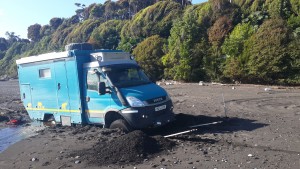
Oh Cuthbert!!
Closer inspection revealed that the front wheels had crossed the small stream and dug-in on the sandbank at the other side, while the back wheels had sunk deep into the stream-bed, well past the axle. Oh Cuthbert!! His tyre pressures had already been reduced to sand-setting and diff-locks engaged to no avail. There’s nothing else for it… we’ll have to dig the sand away and shove the sand-ladders under the wheels for traction. But first we had to dig the sand away from around the back end of the truck to free the sand-ladders from their mounting.
Once we’d freed the sand-ladders, we could start digging the sand away from around the wheels to shove the sand-ladders under the tyres, but the more we dug, the more the stream washed the sand back in. This was déjà vu back to the one other time that we have been stuck in Cuthbert: on a beach in Namibia over 18 months ago! Note to self: ‘Beaches, not good’!
Trying various tactics, we dug and shovelled wet sand around for over an hour. We managed to get the sand-ladders under the front wheels, but the tyres weren’t getting enough traction to drag Cuthbert’s heavy back-end out of the stream. It was now almost 20:00 hrs and things were looking grim; we really didn’t want to spend a night with Cuthbert’s back-end settled deep in a beach-stream. But on the plus side… it was a lovely evening! Clear sky, warm sun and a gentle breeze on a South Pacific beach – there are worse places to get stuck!

Successful recovery… but there are worse places to get stuck!
Eventually we decided to go and check-out some of the large pieces of drift-wood washed-up on the beach ahead of us. Miraculously, we found that the largest piece about 20 meters away was not actually drift-wood, but a stump of a large fallen tree trunk. The majority of its bulk was buried well into the beach and it seemed firm enough to act as an anchor for the winch cable. We gave it a go and… Ha ha!… It worked!!! Phew! Under the power of the mighty winch, Cuthbert slowly crawled out of the stream, onto the sand-ladders and the firmer sand – with around 30 minutes to spare before sunset too! Hurrah!! A celebratory cold beer came out of the fridge to watch the stunning sunset and the seals playing in the surf in front of us! As we said… there are worse places to get stuck 🙂
First Volcano
Our final stop before catching the ferry was the Vulcán Chaitén. Quite exciting! As we head north through the Andes we will certainly encounter many more volcanoes, but this is the first live, smouldering volcano of our trip! Vulcán Chaitén last erupted in 2008 with an explosion rising over 20 km into the sky. When the debris fell, it rendered the local area uninhabitable for several years – until 2011 when the locals returned to re-build their lives. For now it’s keeping a low-profile quietly minding its own business, but there are still Volcano Evacuation Notices on lampposts around the local town of Chaitén.
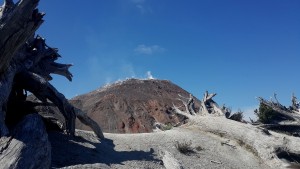
Smokin’
Before the last eruption the volcano had a single crater. The 2008 eruption formed a new cone within the old one, which now reaches higher than the old crater by some 200m. It is possible to hike up to the rim of the old crater to peer over the edge and see the new, higher cone sitting inside. So off we set, towards the rim.
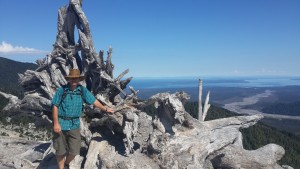
Nice view, but you can’t see the horseflies!!
It was a hot day and the climb rises over 600m in less than 2km of path. Steep! But the real ‘killer’ was the horseflies! Relentless and huge! Scores of them buzzing constantly around our faces as we walked. Heroically, we soldiered on 🙂 ! The dense bright green bushes and ferns were a sign of the recent regrowth, but they were overshadowed by old skeleton trees towering ghost-like above. From the top, the view was rather stunning and a hugely photogenic location. But if we thought the horseflies on the way up had been bad, they were nothing compared to the welcome committee of local ‘bovver-boy’ horseflies waiting to greet us at the top. It was unbearable. With jumpers draped over our heads to fend off the critters, we managed a couple of hastily taken snaps on a mobile phone and then hurried back down the slope. We were rather miffed not to have been able to spend more time up there and take in the beauty and significance of the location, but at least we can say that we have now ‘done’ our first volcano.
Ending at the Start
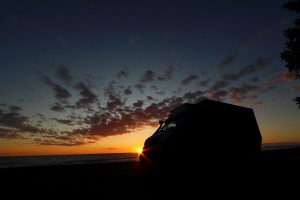
Cuthbert sundowner
Finally, we board the pre-booked ferry for our last section of the Carretera Austral which, true to form, is as scenic as the rest of the route.
We started the Carretera at its southerly end in Villa O’Higgins and we end it over 1,200 km to the north at its start in the city of Puerto Montt. So how has it been?
As the piccies show, it passes through some great scenery and past some interesting glaciers (did we mention the glaciers? 🙂 ). In many sections it is a graded-gravel track, sometimes quite narrow where passing vehicles coming the opposite direction can be a teeth-clenching (yes, we’ll stick with teeth-clenching 🙂 ) experience. The route certainly earns its place in the ‘World’s Top Ten Iconic Road Trips’. However, it doesn’t really live up to the hype of the travel books as a wildly remote and dangerous place, where (allegedly) the un-prepared could get stranded for days or even weeks.
In our experience, you can drive for barely a few minutes without passing another vehicle: local cars, farm-bakkies, trucks, mini-buses, coaches and tourists in hire-cars. South of the Puerto Yungay ferry (towards Villa O’Higgins) the traffic volumes fall off a bit, but there is still a trickle of vehicles running up and down to the ferry three times a day. There are one or two long stretches between villages, so cars with smaller fuel tanks need to fill-up when they can. But pretty much all the villages now have a fuel station, a small hostel and a shop with basic supplies. In winter this would probably be a different story as many places close down and snow is likely to make some of the route dangerous or impassable, but in summer the Carretera Austral is certainly (and with good reason) a hot-bed of commerce and tourism.
Few travellers bother to stop in the commercial city of Puerto Montt and there is good reason for that! But for us it has the rare attraction of a registered Iveco dealer! Cuthbert is due a little TLC with his 80,000 km standard service and we want to have a couple of minor items addressed under Iveco’s world-wide warranty. We had a good service from Iveco’s international network in Namibia, so we’re crossing our fingers that Iveco’s Chilean brothers live up to expectations. We’ll let you know…
Link to next blog: From Iveco to church and back Link to full South America Blog
Carretera Austral Gallery
- Parque Pumalin
- Caleta Tortal

